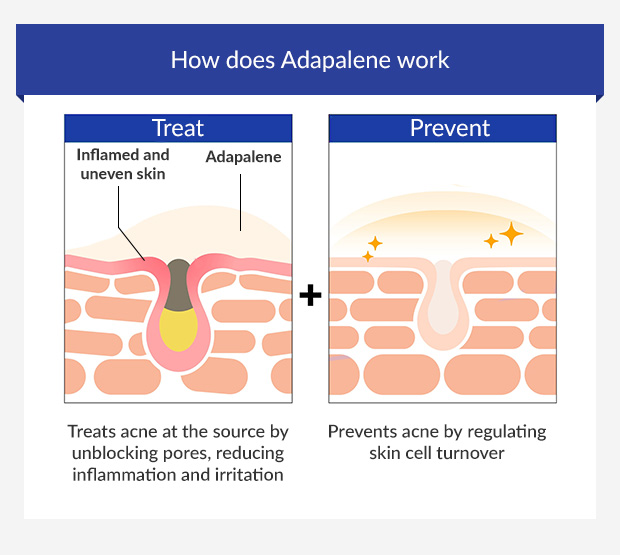Adapalene powder, a topical retinoid derivative, has gained popularity in skincare routines for its effectiveness in treating acne. While it is primarily known for its use on facial acne, many people wonder if it can also be applied to body acne. This blog post will explore the potential use of Adapalene powder for body acne, its effectiveness, and proper application techniques.
How does Adapalene work for body acne?
Adapalene Powder works by regulating cell turnover and reducing inflammation, making it an effective treatment for various types of acne, including body acne. When applied to affected areas, Adapalene penetrates the skin and targets the root causes of acne formation.
The mechanism of action for Adapalene in treating body acne is similar to its effects on facial acne. It works by:
- Normalizing skin cell turnover: Adapalene helps to unclog pores by promoting the shedding of dead skin cells and preventing them from accumulating within the follicles.
- Reducing inflammation: The anti-inflammatory properties of Adapalene help to calm existing acne lesions and prevent new ones from forming.
- Inhibiting the formation of microcomedones: By regulating cell turnover, Adapalene prevents the early stages of acne development, known as microcomedones.

When used on body acne, Adapalene can be particularly effective for treating areas such as the chest, back, and shoulders. These regions often have thicker skin and larger pores compared to the face, making them prone to stubborn acne breakouts. The ability of Adapalene to penetrate the skin and target deeper layers makes it suitable for addressing body acne concerns.
It's important to note that while Adapalene can be effective for body acne, the concentration and formulation may need to be adjusted. The skin on the body is generally less sensitive than facial skin, so higher concentrations of Adapalene may be tolerated better. However, it's crucial to start with a lower concentration and gradually increase as needed, always under the guidance of a dermatologist or healthcare professional.
When using Adapalene for body acne, consistency is key. Regular application as directed by a healthcare provider can lead to noticeable improvements in skin texture, reduced acne lesions, and overall clearer skin on the body. It may take several weeks to see significant results, so patience and persistence are essential when incorporating Adapalene into a body acne treatment regimen.
What is the proper way to apply Adapalene powder on body acne?
Applying Adapalene powder correctly is crucial for maximizing its effectiveness in treating body acne while minimizing potential irritation. Here's a step-by-step guide on how to properly apply Adapalene powder to body acne:
- Cleanse the affected area: Start by gently washing the area with a mild, non-irritating cleanser. Pat the skin dry with a clean towel.
- Prepare the Adapalene powder: If using pure Adapalene powder, you may need to mix it with a suitable vehicle, such as a non-comedogenic moisturizer or gel base. Follow the instructions provided by your healthcare provider or the product manufacturer.
- Apply a thin layer: Using clean fingertips or a cotton swab, apply a thin layer of the Adapalene mixture to the affected areas. Be sure to cover the entire area prone to acne, not just individual spots.
- Avoid sensitive areas: Take care to avoid applying the product to areas with broken skin, cuts, or sensitive regions like the groin or underarms.
- Allow absorption: Give the product time to absorb into the skin before dressing or applying other skincare products.
- Moisturize: If needed, apply a non-comedogenic moisturizer to help prevent dryness and irritation.
It's important to start with a lower concentration and frequency when first using Adapalene on body acne. Begin by applying it every other night or as directed by your healthcare provider. As your skin adjusts, you can gradually increase the frequency to nightly use if tolerated well.

When using Adapalene powder on body acne, keep these additional tips in mind:
- Sun protection: Adapalene can increase skin sensitivity to sunlight. Always use a broad-spectrum sunscreen with at least SPF 30 on treated areas when exposed to sunlight.
- Patience is key: It may take several weeks to see noticeable improvements. Consistency in application is crucial for achieving the best results.
- Avoid other irritating products: Refrain from using harsh exfoliants, alcohol-based products, or other potentially irritating skincare items on the treated areas.
- Monitor for irritation: If you experience excessive dryness, redness, or irritation, reduce the frequency of application or consult your healthcare provider.
Remember that everyone's skin is different, and what works for one person may not work for another. It's always best to consult with a dermatologist or healthcare professional before starting any new acne treatment, especially when using Adapalene powder for body acne.
How long does it take to see results from Adapalene on body acne?
The timeline for seeing results from Adapalene Powder treatment on body acne can vary from person to person. However, understanding the typical progression can help set realistic expectations and encourage adherence to the treatment plan.
Here's a general timeline of what you might expect when using Adapalene for body acne:
- Weeks 1-2: During the initial period, you may not notice significant changes in your acne. Some people might even experience a slight worsening of symptoms, known as "purging," as the skin adjusts to the treatment.
- Weeks 3-4: At this stage, you may begin to see some improvements. Existing acne lesions might start to clear up, and the formation of new breakouts may slow down.
- Weeks 6-8: By this point, more noticeable improvements should be evident. Many users report a reduction in the number and severity of acne lesions.
- Weeks 12-16: Significant improvements are typically observed after 3-4 months of consistent use. The skin should appear clearer, with fewer breakouts and improved overall texture.
It's important to note that while some people may see results sooner, it can take up to 12 weeks or more to experience the full benefits of Adapalene treatment for body acne. Patience and consistency are key factors in achieving optimal results.
Factors that can influence the timeline for results include:
- Severity of acne: More severe cases of body acne may take longer to show significant improvement.
- Consistency of use: Regular application as directed is crucial for achieving the best results.
- Skin type: Different skin types may respond to Adapalene at varying rates.
- Concentration of Adapalene: Higher concentrations may show results more quickly but can also increase the risk of irritation.
- Other skincare products and habits: Your overall skincare routine and lifestyle factors can impact the effectiveness of Adapalene treatment.
To maximize the effectiveness of Adapalene treatment for body acne and potentially see results sooner, consider the following tips:
- Be consistent: Apply Adapalene as directed by your healthcare provider, without skipping applications.
- Use gentle skincare products: Choose non-comedogenic, fragrance-free products that won't interfere with the Adapalene treatment.
- Stay hydrated: Drinking plenty of water can help support overall skin health.
- Avoid picking or squeezing acne lesions: This can lead to inflammation and scarring, potentially delaying improvements.
- Be patient: Resist the urge to switch treatments too soon. Give Adapalene time to work before evaluating its effectiveness.
- Follow up with your healthcare provider: Regular check-ins can help monitor progress and make any necessary adjustments to your treatment plan.
Remember that while Adapalene Powder can be highly effective for many people with body acne, it may not work for everyone. If you don't see improvements after 12-16 weeks of consistent use, consult your dermatologist or healthcare provider to discuss alternative treatment options or potential adjustments to your current regimen.
If you are also interested in this product and want to know more product details, or want to know about other related products, please feel free to contact sasha_slsbio@aliyun.com.
References
- Leyden, J., et al. (2017). Why Topical Retinoids Are Mainstay of Therapy for Acne. Dermatology and Therapy, 7(3), 293-304.
- Thielitz, A., et al. (2008). Topical retinoids in acne – an evidence-based overview. Journal of the German Society of Dermatology, 6(12), 1023-1031.
- Eichenfield, L. F., et al. (2015). Evidence-Based Recommendations for the Diagnosis and Treatment of Pediatric Acne. Pediatrics, 131(Supplement 3), S163-S186.
- Tolaymat, L., et al. (2021). Adapalene. In StatPearls. StatPearls Publishing.
- Brogden, R. N., & Pinder, R. M. (1977). Topical retinoic acid: a review of its pharmacological properties and therapeutic use in acne vulgaris. Drugs, 14(5), 401-419.
- Czernielewski, J., et al. (2001). Adapalene biochemistry and the evolution of a new topical retinoid for treatment of acne. Journal of the European Academy of Dermatology and Venereology, 15(s3), 5-12.
- Veraldi, S., et al. (2016). The use of topical 0.1% adapalene gel for the treatment of acne vulgaris. Clinical, Cosmetic and Investigational Dermatology, 9, 193-197.
- Kolli, S. S., et al. (2019). Topical Retinoids in Acne Vulgaris: A Systematic Review. American Journal of Clinical Dermatology, 20(3), 345-365.
- Thiboutot, D., et al. (2009). New insights into the management of acne: An update from the Global Alliance to Improve Outcomes in Acne Group. Journal of the American Academy of Dermatology, 60(5), S1-S50.
- Millikan, L. E. (2003). The rationale for using a topical retinoid for inflammatory acne. American Journal of Clinical Dermatology, 4(2), 75-80.

